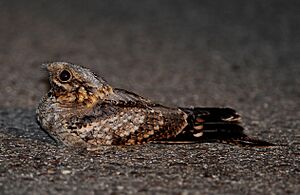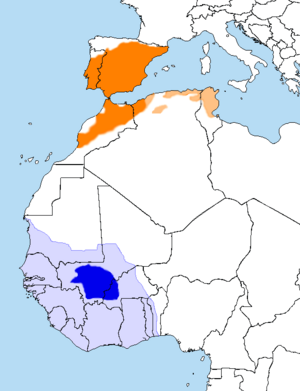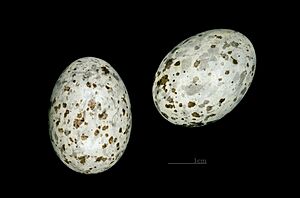Red-necked nightjar facts for kids
Quick facts for kids Red-necked nightjar |
|
|---|---|
 |
|
| In Portugal | |
| Conservation status | |
| Scientific classification | |
| Genus: |
Caprimulgus
|
| Species: |
ruficollis
|
 |
|
| Distribution
breeding winter |
|
The red-necked nightjar (Caprimulgus ruficollis) is the biggest nightjar bird found in Europe. It lives and breeds in Spain and Portugal and North Africa. When winter comes, it flies south to warmer parts of West Africa. This bird is known for its amazing camouflage and its unique calls at night.
Contents
What's in a Name?
The scientific name for the red-necked nightjar is Caprimulgus ruficollis. The word Caprimulgus comes from old Latin words. Capra means "nanny goat" and mulgere means "to milk." This name comes from an old story that nightjars used to drink milk from goats.
The second part of the name, ruficollis, also comes from Latin. Rufus means "red" and collum means "neck." This describes the bird's reddish neck.
The common name "nightjar" was first used a long time ago, in 1630. It describes how the bird is active at night. The "jar" part comes from the special churring sound it makes.
Different Types of Red-necked Nightjars
There are two main types, or subspecies, of the red-necked nightjar. The first one is called ruficollis, which lives in Spain and Portugal. The second type is desertorum, found in North Africa.
The desertorum type from North Africa looks a bit paler. It also has different patterns on its wing feathers compared to the ruficollis type.
How to Spot a Red-necked Nightjar
The red-necked nightjar looks a lot like the European nightjar. Its feathers are a mix of grey, buff, chestnut, and black. This helps it blend in perfectly with its surroundings. It has stripes and streaks all over its body.
This bird is larger and has a longer tail than other common nightjars. It also has a reddish collar around its neck. Both male and female birds have white spots on their wings, tail sides, and throat.
During the day, this nightjar rests quietly on the ground. Its amazing camouflage makes it very hard to see. It looks just like a piece of wood or bark covered in moss. The bird is about 32 centimeters (12.6 inches) long. Its wings can spread out to about 64 centimeters (25 inches) wide. Like other nightjars, it has a very wide mouth, long wings, and soft, fluffy feathers.
The Nightjar's Special Call
The red-necked nightjar makes a unique, repeating sound. It sounds like a mechanical kyok-kyok-kyok.... This sound gets louder and softer as the bird turns its head from side to side.
When it makes this churring sound, the bird usually sits or crouches on a branch or fence. Sometimes, during courtship, it makes a sharp cracking sound. This sound happens when the bird claps its wings together over its back.
Where Red-necked Nightjars Live
These nightjars like open, sandy areas with trees or bushes. They are most active at dusk, which is when the sun sets. They fly with an easy, quiet flight, like a moth. Their strong wingbeats are mixed with graceful glides where their wings stay still.
What They Eat
Red-necked nightjars eat insects that are active at dusk. Their favorite foods are moths and other similar insects. They catch their food while flying.
Reproduction and Nesting
The red-necked nightjar is a late traveler. It usually doesn't arrive in its breeding areas until late April or early May. These birds do not build a nest. Instead, they lay two long, oval-shaped eggs right on the bare ground. The parent bird sits very close to the eggs. This helps to protect them and keep them safe.
Where They Are Found
The red-necked nightjar mainly lives and breeds in the Iberian Peninsula (Spain and Portugal) and North Africa. They spend their winters in tropical West Africa.
Rare Sightings
Sometimes, a red-necked nightjar can fly far away from its usual home. This is called being a vagrant. There have been a few rare sightings of this bird in northern Europe. For example, one was seen in Britain in 1856 and another in Denmark in 1991. These rare visits show how far these birds can sometimes travel.



